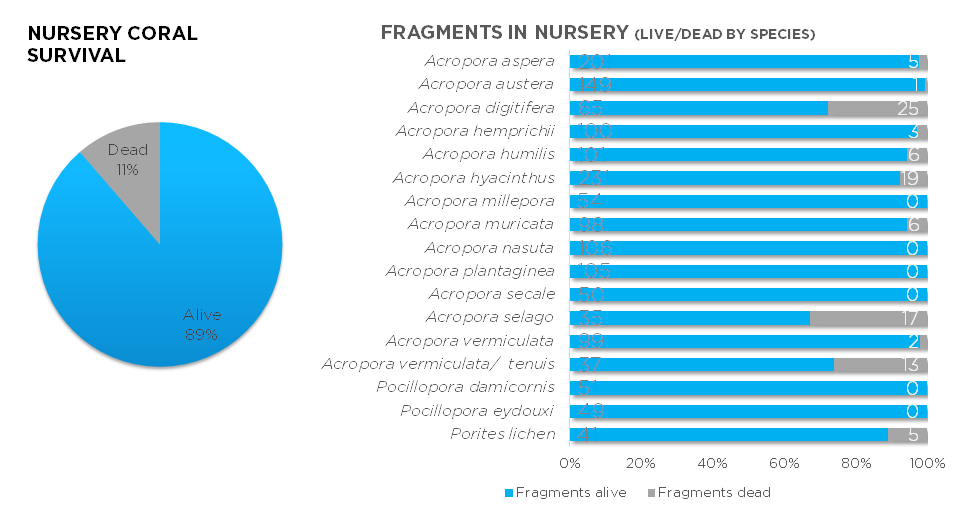After nearly 2 months of hard work that involved unusually large amounts of staring at the computer screen; Debs making the base framework of this report, and amassing large amounts of data, and me trying to summarize it and transform it into shiny graphs, we think we have finally made it! We will be posting updates monthly on our Coral Lines blog from now on.
As of 8th of November, we have 33 coral lines in our nursery. We are experimenting with different growth forms of coral including Staghorn, Table, Bushy and Sub-massive (boulder-like) corals.
A total of 1674 fragments of coral were planted in our mid-water rope nursery to date, and 17 species of coral were used. Out of all the planted coral, 1572 fragments are still alive, with an average mortality of 11% per Coral Line (which is normal, and was due to planting/fragmentation related stress).
A very exciting set of data from coral growth measurements. During the first year (nursery stage) every single coral fragment on each coral line is measured (across the widest point of colony) every 3 months. This allows us to get an estimate of how fast the coral colony grows. So far the data should be treated with caution, since method is very basic, and we need to monitor for one year to get more accurate estimates. Nonetheless, you can see what we have found to-date. The fastest growing corals were staghorn (Acropora aspera & A. muricata), expanding more than 3 cm in just 3 months! The majority of other corals grew less than 1 cm in 3 months, just highlighting how slowly coral reefs form.
Since 75% of each Coral Line donation goes towards GILI SEAS (Social, Environmental Awareness and Sustainability) fund, we are also reporting on the financial side of the project. As far as donations go, you can see that we hit the record of 9 donations in October, and we are currently working toward a system whereby those who wish can donate online. We would like to thank all the guests who have donated so far!
We have also used some of our fund already with the two major spending areas being equipment and cloud storage. Equipment included a temperature logger, weighing scales and calipers. Since the early stages of project, cloud backup was necessary to ensure that all our precious data was backed up and therefore not lost!
What is the plan for the future?
We are constantly working hard to develop and improve our methods using current literature as well as trial and error in a bid to produce excellent scientific data which will be of publishable standard in a peer reviewed journal. As we learn, we are documenting our findings and we hope to create a user friendly manual that can be used to guide others in the field. We also plan on continuing our focus on raising awareness by planting more lines with guests, providing more information online, and sharing our findings where possible.




